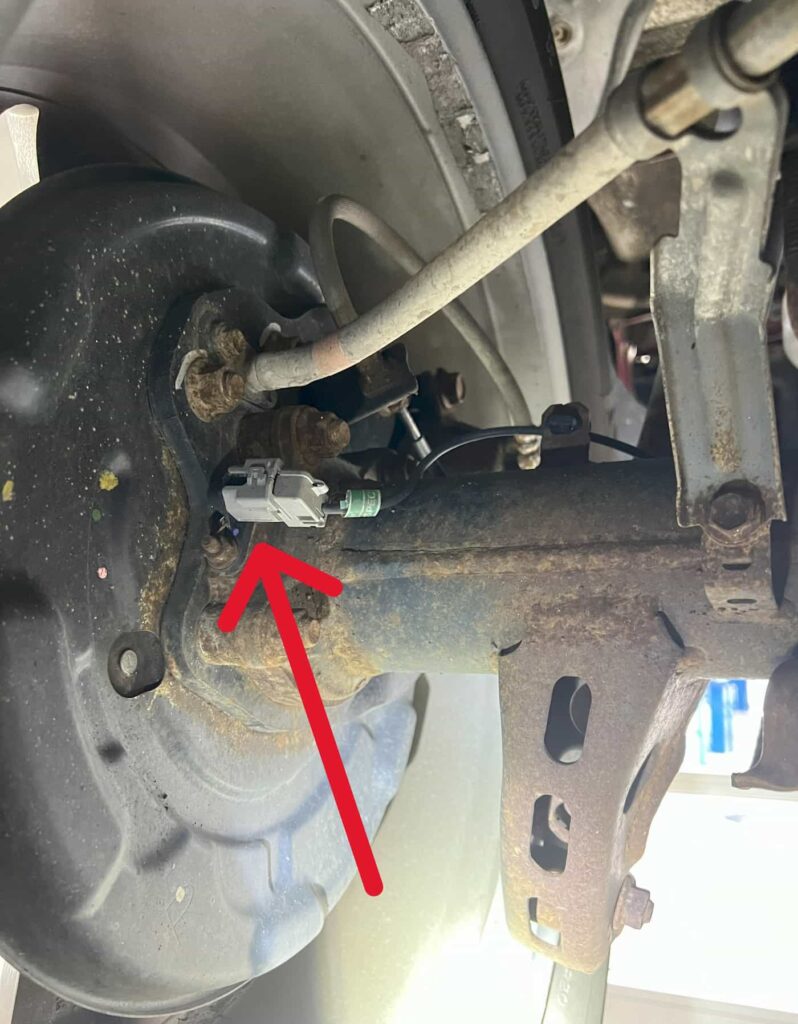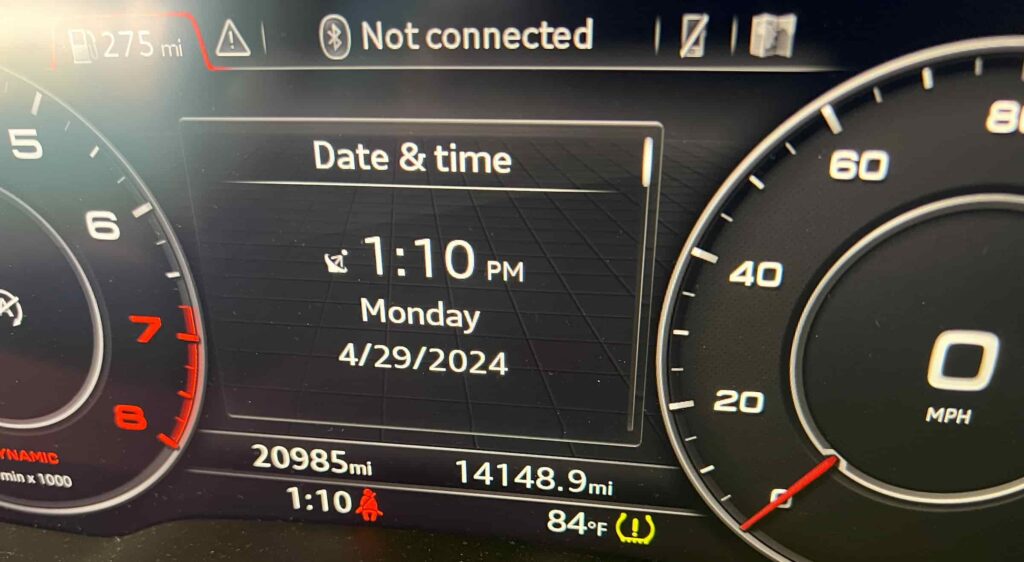Steps to Reset the Audi TPMS
2016-2025 Audi TPMS Reset
Inflate each tire to the exact air pressure found on the tire pressure sticker located on the inside of the driver side door panel.
Start the Engine.
Select VEHICLE on the touch screen display.
Select SETTINGS & SERVICE.
Scroll down on the touch screen, select TIRE PRESSURE MONITORING.
Select STORE TIRE PRESSURE.
Select YES, STORE NOW.
2016 Audi TPMS Reset
Inflate each tire to the exact air pressure found on the tire pressure sticker located on the inside of the driver side door panel.
Start the Engine.
Press the MENU button under the scroll wheel.
Select VEHICLE from the information display options.
Push the scroll wheel to the left to select more options.
Select SERVICE & CHECKS.
Select TIRE PRESSURE MONITOR.
Select STORE TIRE PRESSURE.
Select YES, STORE NOW.
2011-2015 Audi TPMS Reset
Inflate each tire to the exact air pressure found on the tire pressure sticker located on the inside of the driver side door panel.
Start the Engine.
Press the MENU button under the scroll wheel.
Select CAR.
Press the bottom left button next to the scroll wheel to select CAR SYSTEMS control button.
Select SERVICING & CHECKS.
Select TIRE PRESSURE MONITORING.
Select STORE TIRE PRESSURES.
Select YES, STORE NOW.
2008-2012 Audi TPMS Reset
Inflate each tire to the exact air pressure found on the tire pressure sticker located on the inside of the driver side door panel.
Start the Engine.
With the tire pressure displayed on the screen, push and hold the RESET button on the bottom of the stalk on the right side of the steering wheel for 10-15 seconds.
Select SET by selecting and pressing reset.
Select Tyre Pressure by pressing the reset button.
Select STORE.
What Can I Do if the Audi TPMS Warning Light Won't Turn Off?
Use a tire pressure gauge to check each tire’s pressure before starting other troubleshooting steps. It’s crucial to use a tire pressure gauge to check the current PSI of each affected tire and fill it with air until it reaches the appropriate PSI. Compare the actual tire pressure against the recommended level. This initial step ensures that all tires are at their correct pressure levels, which could resolve the TPMS warning light issue without further intervention.
Inspect all four tires for leaks by spraying soapy water on the treads, around the tire beads, and valve stems after inflating to locate any air leaks.
Disconnect the negative battery terminal for a few minutes to reset the Audi computer system, potentially clearing any TPMS fault codes.
Deflate each tire by around 10 psi (pounds per square inch), then reinflate to recommended pressure; drive for at least 10 minutes at 20+ mph and then follow TPMS reset procedure.
Use an OBD scan tool to diagnose any tire pressure monitoring system fault codes in the on board computer. Confirm that each wheel speed sensor is working properly.
How Does the Audi Tire Pressure Monitoring System work?
Audi vehicles are equipped with an indirect Tire Pressure Monitoring System (TPMS) that does not use individual tire pressure sensors within each wheel. Instead, it monitors the rotational speed of each tire using the Anti-lock Braking System (ABS) wheel speed sensors. If one tire is underinflated, it will have a slightly different rotational speed compared to the properly inflated tires. The system detects this difference and illuminates the TPMS warning light on the dashboard to alert the driver.
Why Does the Audi TPMS Light Turn On?
The Audi TPMS (Tire Pressure Monitoring System) light can turn on for several reasons beyond just low tire pressure. Here are some more specific details:
Mismatched or Incompatible Tires/Wheels: Audi’s indirect TPMS system relies on monitoring the rotational speeds of each tire using the ABS wheel speed sensors. If you have mismatched tires (different sizes, brands, tread depths) or aftermarket wheels that are not compatible with the system, it can throw off the rotational calculations and trigger the TPMS light.
Tire Rotation/Replacement: After performing a tire rotation or replacing one or more tires, the TPMS system needs to re-learn the new tire positions and circumferences. If not reset properly, it can cause the light to illuminate on the Audi dashboard.
Wheel Speed Sensor Issues: Since the TPMS relies on the ABS wheel speed sensors, any fault or malfunction with those sensors or wheel hubs can lead to inaccurate readings and the TPMS light turning on, even if the tire pressures are correct.
Loss of Traction: The indirect TPMS system monitors for differences in rotational speeds. If a tire loses traction (e.g. driving on ice or snow), it can temporarily trigger the TPMS light until traction is regained.
Importance of Proper Tire Pressure
Maintaining proper tire pressure, is crucial for several reasons:
Safety: Underinflated tires can lead to premature tread wear, reduced traction, a rougher ride, and increased risk of a blowout.
Fuel efficiency: Underinflated tires create more rolling resistance, which can decrease fuel economy.
Handling: Properly inflated tires provide better handling, braking, and a smoother ride.
What is the TPMS System Fault on My Audi? Why is the Tire Pressure Light Flashing?
If the TPMS warning light is flashing, it indicates a system fault or malfunction. This could be due to a faulty wheel speed sensor, a problem with the TPMS control module, or interference from aftermarket wheels or tires. A flashing light does not necessarily mean a tire is underinflated, but it does require further diagnosis and potential service.
Does Driving With the Spare Tire on Trigger the Audi TPMS Light?
Yes, driving your Audi vehicle with the spare tire or donut tire will cause the tire pressure light on the dashboard to turn on.
Is It Ok to Drive with TPMS Light On?
No, it’s generally not recommended to drive for an extended period with the TPMS warning light illuminated. This indicates that one or more tires are significantly underinflated, which can lead to poor handling, increased wear, and a higher risk of a blowout. It is best to check and adjust the tire pressures as soon as possible.
Do Audis Have TPMS Sensors?
No, Audi vehicles do not use individual tire pressure sensors within each wheel.
Why is My Audi Tire Pressure Light on When My Tires are Fine?
If the TPMS warning light is on, but your tire pressures appear to be within the recommended range, there could be a few potential causes:
Sensor Issue: A faulty ABS wheel speed sensor or TPMS control module could be causing the system to malfunction.
Aftermarket Wheels/Tires: Non-compatible aftermarket wheels or tires can interfere with the TPMS system and trigger the warning light.
Recent Tire Service: If you’ve recently had your tires rotated or replaced, the TPMS system may need to be reset or recalibrated.
Can I Disable the Audi TPMS?
It is not recommended to disable or deactivate the Audi TPMS system. The TPMS is a federally mandated safety system designed to alert you to potential tire issues that could compromise your vehicle’s handling and safety.
Will Temperature Changes Cause the Audi TPMS Light to Turn On?
Yes. Colder temperatures cause the air inside tires to contract and become denser, resulting in lower pressure levels. This can occur over the course of a day, week, or months. This drop in tire pressure, even if slight, can trigger the TPMS (Tire Pressure Monitoring System) warning light on an Audi’s dashboard during cooler seasons. Check your tire pressure with a tire gauge at least once every few weeks to prevent this issue.
To learn more about your specific Audi, check out these articles: Audi Q8/SQ8, Audi Q7/SQ7, Audi Q5/SQ5, Audi A8, Audi A7, Audi A6, Audi A4, Audi Q3, Audi A3, Audi A5,
Please note that this blog post contains Amazon affiliate links. This means that if you make a purchase through one of these links, we at TPMSRESET.COM may earn a small commission at no extra cost to you. We only recommend products that we personally use and believe in. Thank you for supporting us.
About the Author
Stefan A. – Professional Automotive Technician – I am currently an automotive technician in New Jersey and have worked in private shops as well as dealerships. When I am not writing articles I am wrenching on race cars and driving radio controlled cars at the track!




